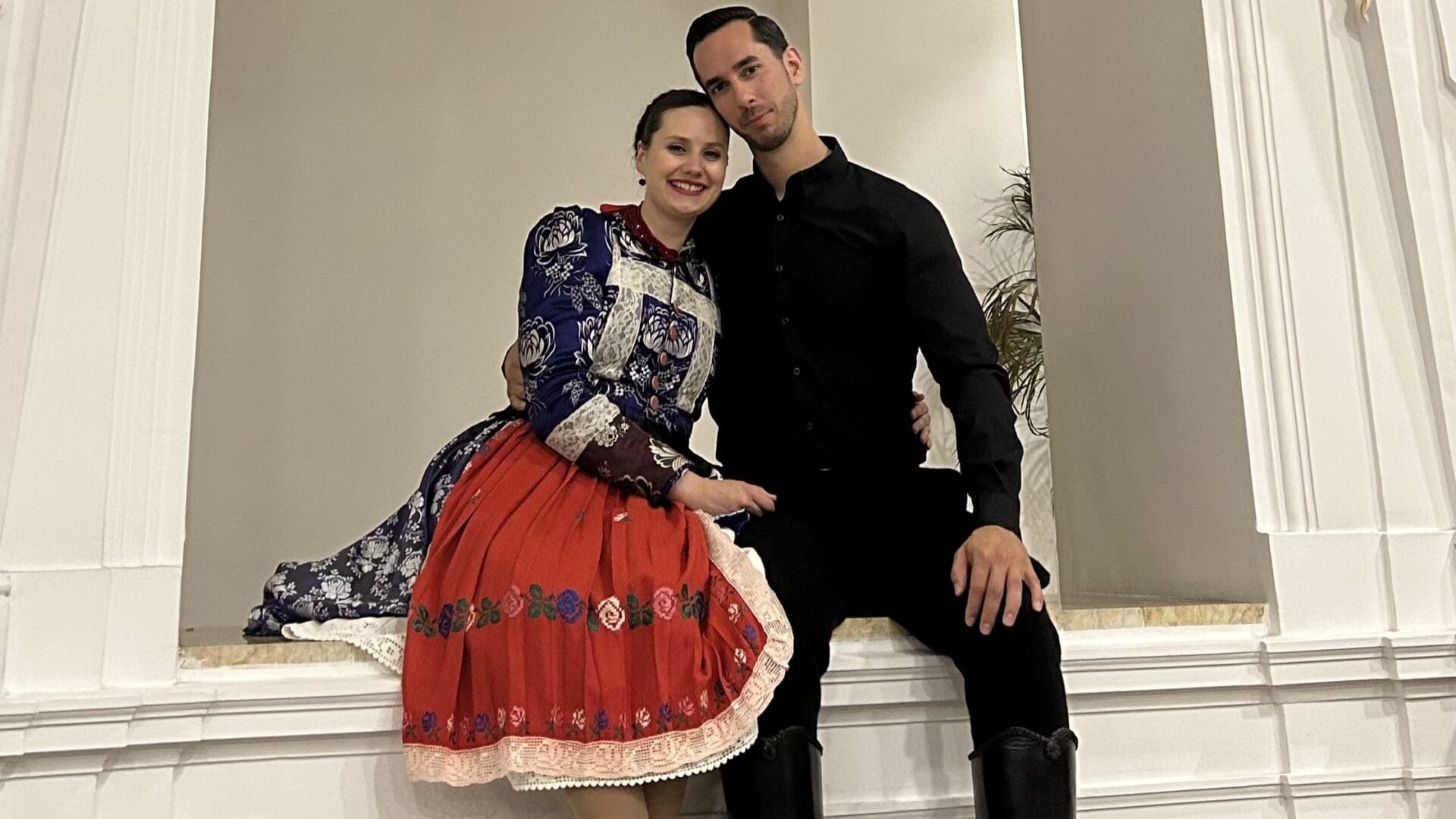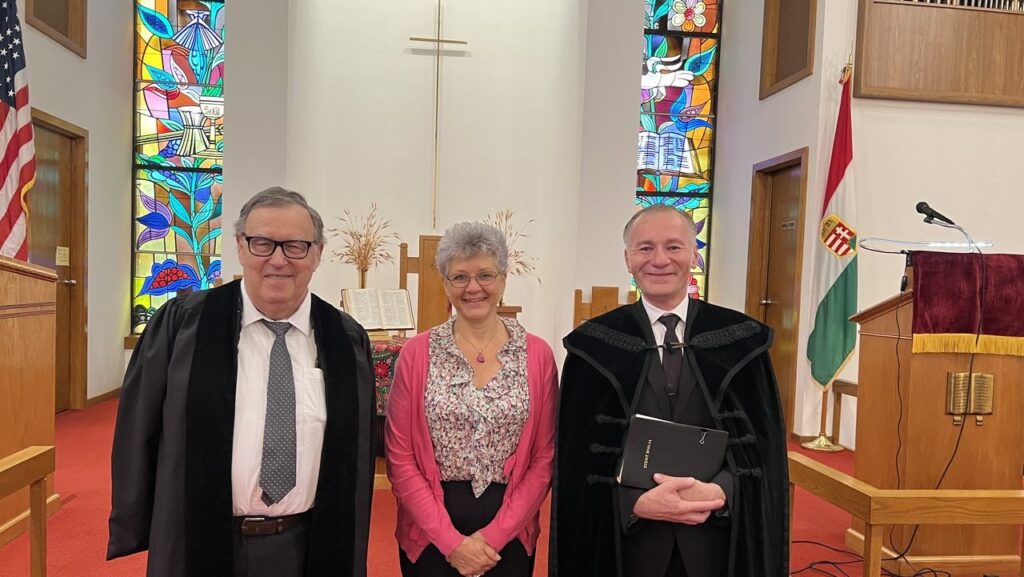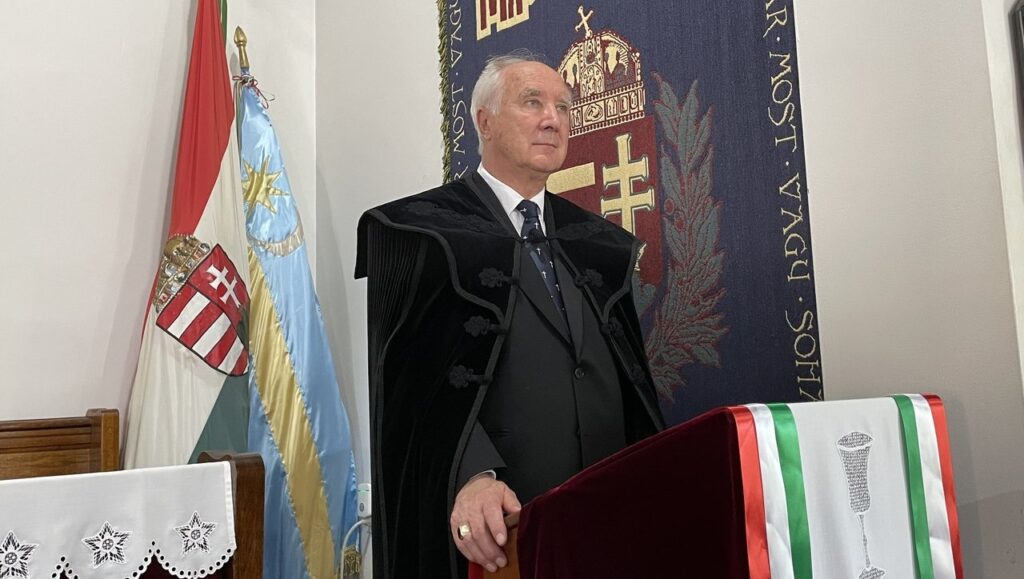The Hungarian community in New Brunswick has been hosting Kőrösi Csoma Program (KCSP) scholars specialized in folk dance for quite a while now, and over the last two years directly from the Angyalföld Vadrózsa Dance Ensemble. Lili Balogh and István Dániel Molnár have not only been involved in training five folk dance groups in New Brunswick, but have also helped a number of local Hungarian organizations in multiple ways and in relation to several Hungarian events.
***
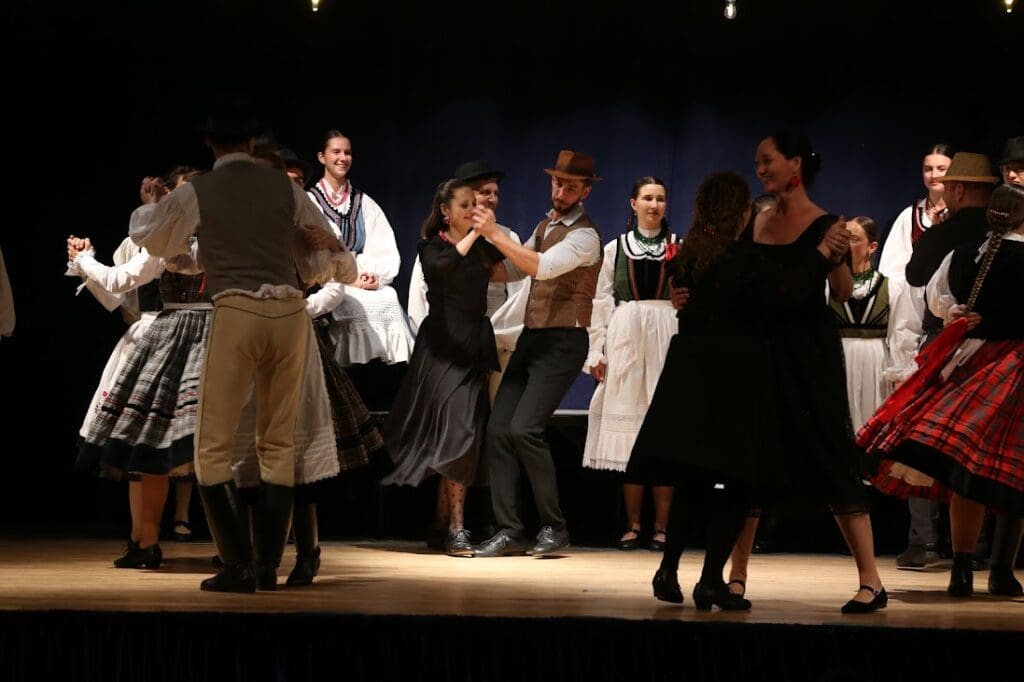
Where are you from and what do you do at home?
Lili: I was born in Dunaújváros, Hungary. At the age of 18, I applied to the Faculty of Teacher Training College of the Károli Gáspár Reformed University in Budapest, and then I immediately started working as an English teacher and elementary school teacher in Budapest.
Isti: I was also born in Dunaújváros. We both grew up in the long-established Vasas Dance Ensemble of Dunaújváros. I joined its teaching staff in 2012, and in 2015 I took over the artistic direction of an ensemble in a nearby village. I joined Vadrózsa in October 2018, having previously danced with the Szentendre Dance Company. Lili and I found each other in 2018, and a year later we lured her to Vadrózsa. There, I first helped with the talent program, preparing soloists for competitions, and in 2022 the lead trainer role of the most senior group was assigned to me. Before we came to the U.S., I also worked for five years as a music and folk dance teacher in an elementary school in Ercsi. This is a municipality with a lot of disadvantaged families living in deep poverty, so this was a big mission for me. I was also working part-time at the Urbán Verbunk art school in Gödöllő dealing with 10–12-year-old children. This is the only dance theatre company in the country for juniors, with a lot of acting involved. They are accepting me back full time as soon as we get home.
How did the connection between Vadrózsa and New Brunswick come about?
Lili: The Vadrózsa Dance Ensemble was founded in 1992. The current artistic directors, Kristóf Fundák and Lili Fundák-Kaszai, took over the artistic direction in 2009. They have entered the group to the national folk dance movement, where they have been achieving good results in professional forums and competitions for several years. It is among the top non-professional folk dance companies at this point. In addition, Lili and Kristóf have been active in the Hungarian American diaspora for many years. They have been regular guests at the Csipke Tábor (Lace Camp) organized by József Salamon and his wife, Andrea annually for 15 years. They also often travel to Canada, visiting Calgary, Winnipeg, Montreal, and Detroit to organize Hungarian folk dance workshops there. In the Csipke Tábor they have developed a close relationship with the Hungarian folk dance community from New Brunswick. The Mákvirág children group in New Brunswick and the Vadvirág children group in Budapest became sister groups.
Prior to the Covid pandemic, Dénes Kovács and Vivien Nagy were KCSP scholars in Los Angeles at the Kárpátok Dance Ensemble, then led by Lívia Schachinger, who has since moved to New Brunswick and is now one of the leaders of the Szilvafa Dance Group and one of the KCSP-mentors, along with Melinda Török, who leads Mákvirág.
Why did you apply for the KCSP scholarship?
Lili: Last June, we were approached by the 2022–23 New Brunswick KCSP scholars Gábor Szanyó and Viola Kovács. They suggested that we should step in their shoes and apply for the 2023–24 cycle. We thought about it for a day or two and decided to take it on. Our employers were also very flexible about it, we could both take unpaid leave and agreed to come back in a year. Back in June we already had an online meeting where we met our mentors, Melinda and Lívia.
Isti: Even though everybody tried to provide us with all the information, we realized quite quickly that there is no way to prepare for this scholarship. As we arrived late, we were in the fortunate position of being immediately involved in the community’s life: we arrived on Thursday, and the next day we had a rehearsal for the Csűrdöngölő, where we were welcomed as if we had known each other for months. Lívia and her family picked us up at the airport and brought us here, where we were greeted with a small gift basket with enough food and drink for a few days, which was very nice, because we hadn’t thought about that before. These are the very first, very positive impressions that I think will last a lifetime.
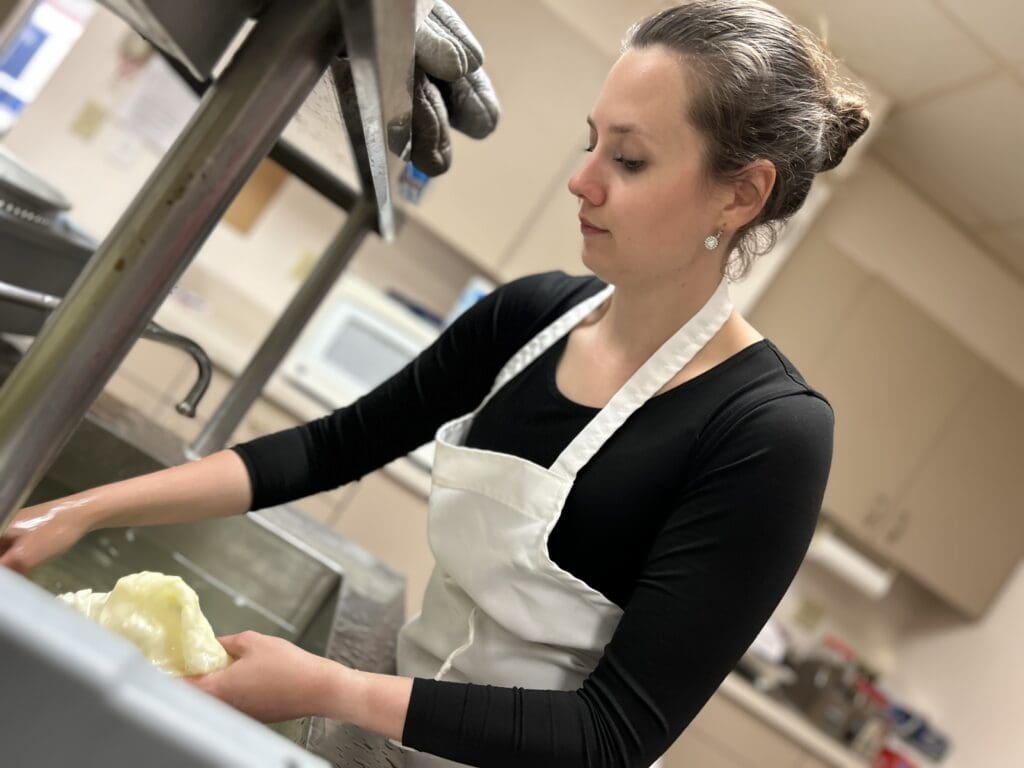
Is this your first time in America?
Lili: Actually, it was the first time we had ever flown, the first time we had been overseas, so we were very excited about this trip. And well, America is a very different culture, so at the beginning we were just scratching our heads... Without a car, it’s practically impossible to go shopping, so we had to rely on others, which was a bit difficult at first, at least for me, because I don’t like asking for favors; but then we developed good relationships with a lot of people who we could always rely on. One of the dancing mothers, Enikő Kovács, said: ‘In three days you picked up the rhythm and blended into the Hungarian community as if you had been here for years.’ Obviously, it depends on your personality how quickly you can integrate, but this community has also done its best.
I wouldn’t dare to embark on such a journey alone, but together everything went easier, including integration.
Let’s talk about your KCSP tasks in more detail.
Lili: New Brunswick has a lot of folk dancers, so the main thrust for us was folk dance education and strengthening the dance communities. We taught in the two older children’s groups at Mákvirág, the young adult Csűrdöngölő, the older Szilvafa and the Regös scout folk dancers. We both taught at the Széchenyi Hungarian school on Saturdays. Every Wednesday we helped at the Reformed Church, from office work to cooking and from packing to organizing the archives. On Thursdays, we helped at the Hungarian Museum. They’ve recently started an archiving project, so there were times when they had to type it up, but otherwise it was mainly physical work: preparing for the monthly market, setting up tables, displaying handicrafts, packing, moving books, preparing exhibitions, etc.
Isti: On Fridays we were at the Club (the Hungarian American Athletic Club, HAAC) when we were needed. There we usually had to help with the cooking if there was a Friday night dinner, or digitize pictures, set the table and wipe glasses for balls. Back in October, all the organizations sat down with us and clarified when and what they were expecting us to do. We didn’t receive such a request from the HAAC at that time, only later and rather strangely: we were often called unexpectedly to drop in immediately and they didn’t understand why we weren’t available. There was no proper communication, which was also due to the fact that at that time there was a big mess at the Club’ leadership which made our stay difficult at the beginning, but when the HAAC management was sorted out by the spring, communication became much better. We recommend to the next KCSP scholars to sit down with each Hungarian organization at the outset and clarify what the expectations are. Obviously unexpected things can always happen and it’s good to be flexible, but it is always worth knowing the duties and keeping the limits.
What was your specific task in terms of folk dancing?
Lili. We tried to show each folk dance group something new, while strengthening their community. This year there was no Pontozó, the biggest Hungarian folk dance competition in the U.S., but Melinda wanted a bigger folk dance show. She first thought about the Toborzó, which is a bit like a folk dance festival in Hungary. We started organizing this three-day event in the autumn, but in the end we decided that it would be too much, so instead we had the end-of-season gala on 11 May, and they also performed their shows partly at the Hungarian Festival on 1 June.
Isti: We were expected to put together a gala show of at least an hour, preferably with as much dancing and as little music or prose as possible. We therefore tried to keep the choreographies long enough, but still enjoyable. In addition, we tried to show everything that is relevant to the various regions and to convey it in a way that does not detract from the experience. To us, from the moment the dancers take to the stage, it is no longer a folk dance but a show. It is authentic folk dance that was danced in barns in the 1940s, 1950s and 1960s, and then in folk dance halls from the 1980s onwards. But as soon as we put it on stage, it becomes a show. People here have had to understand and accept that if they want to be on stage, they have to put a lot more work into it as opposed to just dancing for themselves. If they are dancing for the audience, they have to capture their interest from the first second to the last. That’s why we pay attention to the view, not just the dance and the music. Obviously, Hungarian folk dance is very spectacular, but we still have to make it exciting. Gabi Vajtay had a very good saying in relation to the Hungarian Festival: she would like to see something exciting, and not a 50th folk dance from Szék... The stage production has to be appropriate for today’s audience, both in terms of visual and audio experience. Authentic folk dance, however, no longer serves this purpose; you have to add a lot of extras, but from then on you can no longer call it folk dance. I think they got what I was trying to convey. I always tell my groups in Hungary: you can learn folk dance, but you won’t go on stage at year-end.
Lili: Different practices and rules apply everywhere. Here, the dance teachers do a mind-boggling and endless job, constantly adapting and looking for solutions to things that they shouldn’t even be dealing with... If you want to belong to a community, you should submit to its rules. Here we have seen the opposite, especially in the children’s groups: teachers subordinate themselves to children. In the case of the two older Mákvirág groups, we have managed to make them understand our point and we are very confident that the group will act accordingly next year. It is in their interest.
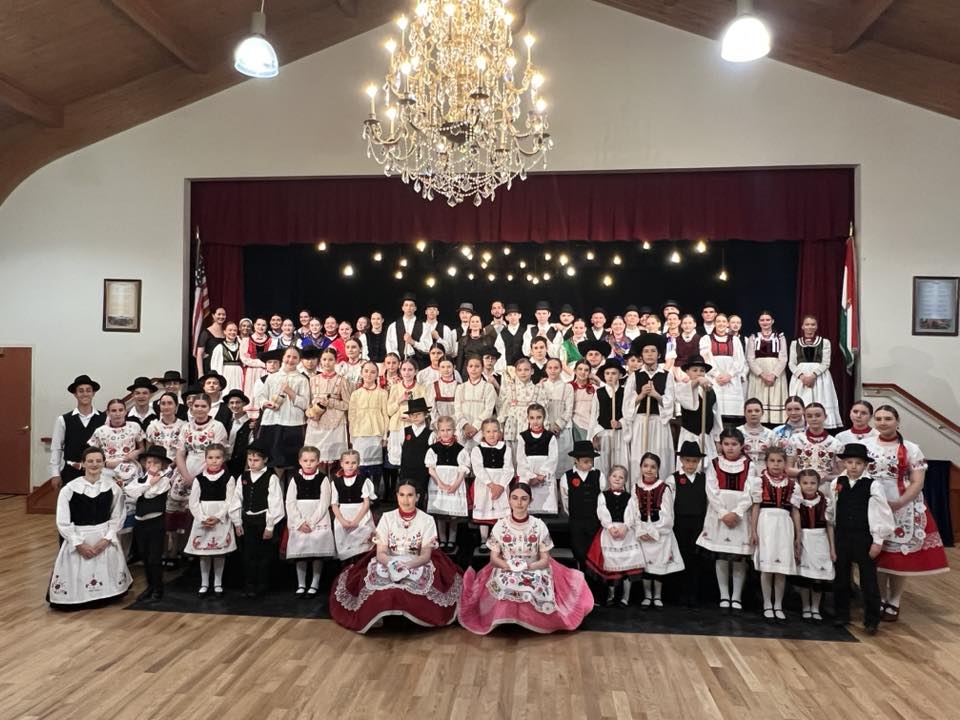
We haven’t even mentioned whether they’d come to the rehearsals or not...
Isti: True, but we want everything. We strive for our students to learn how to dance, so they can master all the steps and motifs we teach them and can use them freely when they go to parties, dance clubs or at home. There is obviously a big difference between being able to apply what they have learned freely and being able only to dance the sequence they have learnt. In the latter case, if they are in a different venue or stage, they can easily get confused and lose track of where they are. Our main goal—and not only in America, but also in Hungary—is that they learn the dance material at a native level, at least the motifs and figures we teach them. Building on this, we can start to produce series of movements and choreographic elements.
Lili: Folk dance groups in the Hungarian diaspora are in a more difficult situation in this respect, because they only have one rehearsal per week. In that 2,5 hours they have to get the children to like and learn folk dance, master the motifs and stylistic elements of the regions, and even put together a choreography, so that they can perform at the May show and at the Hungarian Festival. In Hungary there are usually two rehearsals per week, and there are summer camps and regular weekend camps. Here, if a kid is sick, if it’s snowing heavily and people can’t get into town, if there’s a longer scouting program, then there’s no dancing for two weeks... However,
we believe that folk dance training doesn’t end in the rehearsal room,
so we’ve made an effort to organize some kind of a team-building camp or day for every group. The impact was very impressive. For example, we held a two-day training camp for the Regös group back in October. These two days together started a close bonding between the young people that gave a very good impetus to the whole year. Previously the group went with six couples and about 12 children, this year there are now 25 children. The older and the middle group of Mákvirág had a training camp in January, but we also organized a party night for the older ones. Almost everyone participated and they had a great time.
Isti: But the biggest camp experience was with the adult group Csűrdöngölő for whom we had a three-day training camp they had never had before. They’ve had long Saturday or weekend rehearsals, but never before have the 25 dancers traveled somewhere for three days. We were aware that not everyone could get away for three days, so we didn’t make it compulsory, but we did state that only those who would be attending the camp would be involved in the choreography, because we would put it together only there and not during the regular rehearsals. We promised that by the time the training camp started at Magyar Tanya, Pennsylvania, everyone would be able to dance so freely from the material they had heard all year that we would put the choreography together in three days. They were reluctant at the beginning, very tense and worried, but practically half of the choreography was done on the first night, and from then on the camp was very good fun. In terms of community building, it’s very important to have long weekends, not just long days together. They need weekends like this, so that they can do what they love to do, stress-free, relaxed and unhurried…and together. Hopefully they’ll continue it from now on.
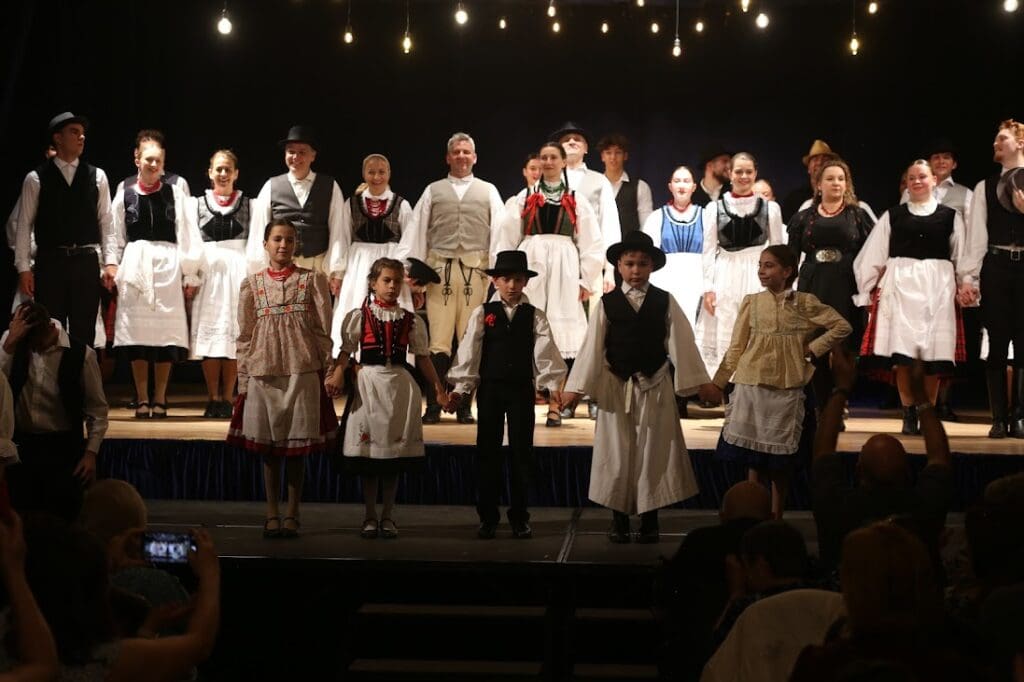
How have you been involved in the preparations for the Hungarian Festival, the biggest event in the local Hungarian community life?
Lili: We indicated to our mentors and to the local organizations that we would be completely free during the week of the festival, we only asked them to let us know in time when and where they needed us. Everything went smoothly; there was only one day of tension, the previous Friday, when we had to make chicken paprikash for 800 people at the Club. Everybody knows how good a cook Łívia is, but she has never made chicken paprikash in such quantity, so she said: whatever happens, it’s everyone’s responsibility, not just hers. As we heard back, it was delicious, but on the day we worked from 9am to 9pm, lifting big pots and pans to and from the stoves, and cleaning 1,600 chicken legs and continuously stirring the paprikash...
Isti: …it made everyone sweat. We were racing against time, checking the clock every minute, which stressed us. But maybe next year it will be easier. Otherwise everything else went smoothly, and overall we had a good time at the Festival.
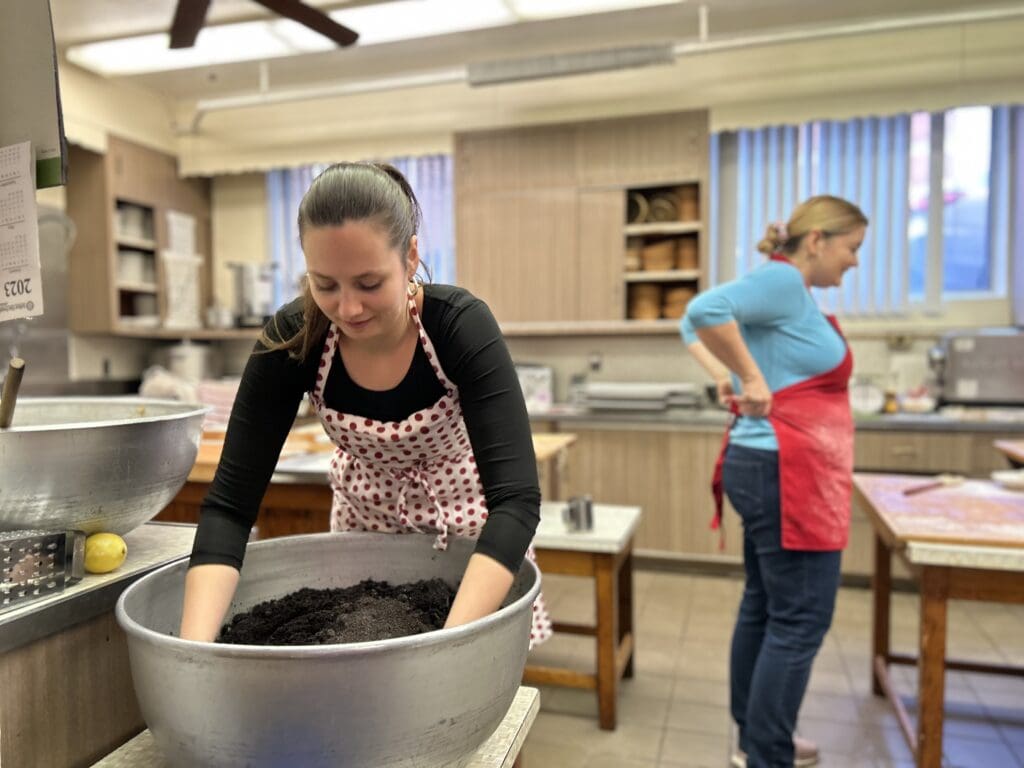
Tell us about what you’ve seen of the U.S. beyond work and New Brunswick.
Lili: We visited nearby New York several times. We also got to Cleveland once but unfortunately haven’t had time to go back since then, even though we promised.
Isti: We accompanied the New Brunswick Regös dance troop to the Golden Wedding because they were invited by the Cleveland Regös dance group, whom they had met at various scouting events and developed a close relationship. The two groups tried several times to put together a troop-building weekend, but it didn’t work out due to the busy schedules and long distance. The show was the first foreign Hungarian cultural event that was shockingly amazing to experience. We had no idea that Cleveland would have such a deep bench and ecosystem for Hungarian folk dance. Almost every Regös dancer from the past 50 years performed on stage with an attitude and quality that trumped even professional folk dance companies in Hungary. A good example to follow!
Back to the question...
Lili. During spring break we were in Arizona, where we visited the Grand Canyon. We stayed in Sedona, where we hiked almost all the hiking trails. We had a meaningful, life-changing experience. Also because Isti proposed to me there...
Isti: Indeed. Our next long holiday will be a trip to Florida with some friends. We have also been to Canada. We went to Montreal for a workshop given by our art directors Lili and Kristóf, and we had some time to look around and see the city. If all goes well, we will return with the Vadrózsa Dance Company for a two-week East Coast tour from October 18–19 to November 3–4.
Congratulations on the engagement! What is KCSP good for... Do you keep in touch with the other scholars?
Lili: There was a so-called preparatory meeting in September, organized by the State Secretariat for Hungarian Communities Abroad. We participated in different presentations for three days, where we got to know all the other KCSP scholars coming to the U.S. for this year. The leaders of our team are István and Ágnes Vámosi, who had already had a year of experience, having lived in Los Angeles. István suggested that after the formal meetings we should introduce ourselves more informally. Later, a Facebook group was set up and we held two–three video meetings, where everyone could tell us how things were going and help each other if needed. There will be a closing conference on 10 July, after which we would like to meet again informally, so that after nine months everyone can share their own experiences. We can learn a lot from each other and what we share can also help the program. I’ve started to put together a list of useful information and advice for the newcomers.
Isti: Friendships have also developed between KCSP scholars, and we can call Bence Hajdu from Washington, DC and Daniel Indri from New York friends. We also have a good relationship with Marci Hajdú from Passaic/Garfield, who stayed with us once. Over Thanksgiving, several KCSP scholars came to visit us.
You’re going home soon, but I suspect the connections will remain. You’re coming back in the fall, and we recently had a farewell party at the Hungarian House in New York for six young adults who will be studying in Hungary.
Isti: We’ve already indicated to them and their parents that we’re going to create a chat group where we’ll provide all the necessary information for them. If they need any help, they should let us know. We plan to have a Budapest–New Brunswick monthly meeting so that everyone can report on their studies and how they are feeling. We’ll pick up those who are traveling alone at the airport. We don’t let go of their hands; we want to give back the good things we’ve received from them.
What are the three most important things you take home from here?
Lili: The positive American attitude that the Hungarians born here also have. For example, Csilla Varga’s positive outlook and world view really struck us. She sees the world so differently and has such a different approach to problems than we are used to back home. She focuses on the solutions and doesn’t despair if something doesn’t work out as planned. She is aware that everyone is volunteering here and sets her expectations accordingly.
The other is the power of teamwork. If they see something failing, they follow it up until it’s resolved...or let it go.
Isti: Thirdly, I would like to send a message to the Hungarians back home: there are Hungarians in the U.S., come and see what it’s like to be a Hungarian here...
Related articles:

